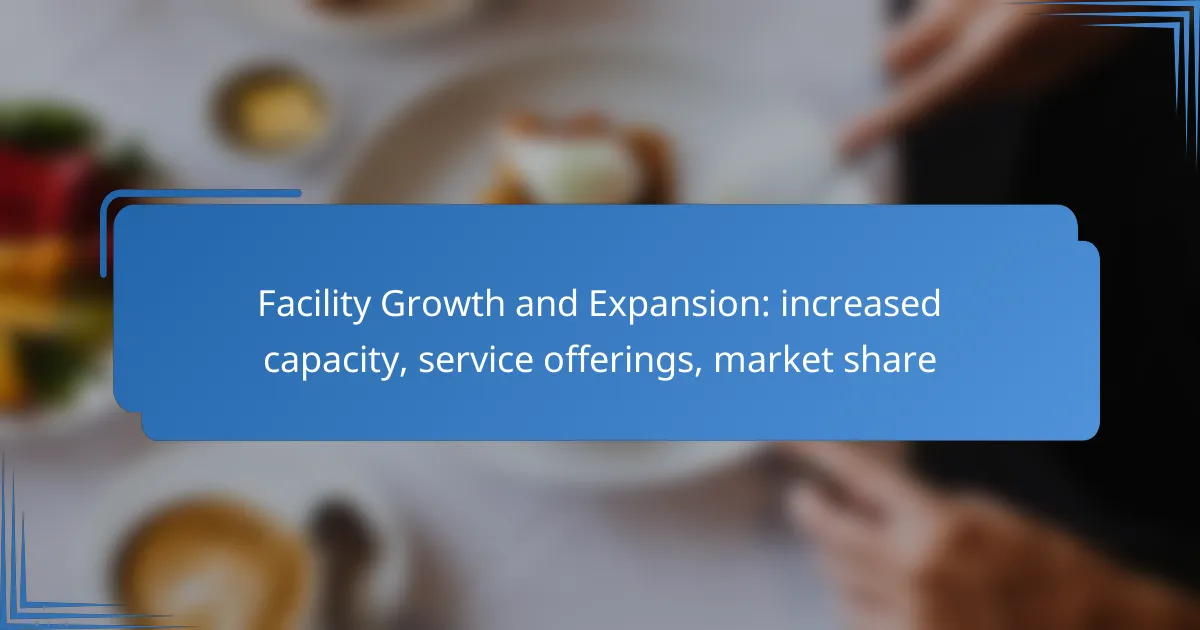Facility growth and expansion are crucial for businesses aiming to increase capacity and enhance their market share. By adopting advanced technologies and optimizing operations, facilities can effectively manage higher volumes and broaden their service offerings. Understanding local consumer preferences and implementing strategic initiatives further positions businesses to capture a larger segment of the market.

How can facilities in Australia increase capacity?
Facilities in Australia can increase capacity by adopting advanced technologies, expanding their physical footprint, and optimizing operations. These strategies enable businesses to handle more volume, enhance service offerings, and ultimately grow market share.
Investing in automation technologies
Automation technologies can significantly boost a facility’s capacity by streamlining processes and reducing manual labor. Implementing systems like robotic process automation (RPA) or automated storage and retrieval systems (AS/RS) can enhance efficiency and accuracy.
For example, a warehouse might use automated picking systems to speed up order fulfillment, allowing it to handle a higher volume of shipments without increasing workforce size. Facilities should evaluate the return on investment (ROI) of such technologies to ensure they align with growth objectives.
Expanding physical space
Increasing physical space is a straightforward way to enhance capacity, whether through new construction or leasing additional facilities. Facilities should assess their current layout and workflow to identify areas where expansion can alleviate bottlenecks.
Consideration of location is crucial; facilities in urban areas may face higher costs but benefit from proximity to customers. A facility might expand by adding a new wing or relocating to a larger site, depending on budget and strategic goals.
Implementing lean management practices
Lean management practices focus on maximizing value while minimizing waste, which can lead to increased capacity. By analyzing workflows and eliminating non-value-added activities, facilities can operate more efficiently.
Techniques such as value stream mapping and continuous improvement initiatives can help identify inefficiencies. Facilities should train staff in lean principles to foster a culture of efficiency and adaptability, ensuring that capacity increases are sustainable over time.

What service offerings can be expanded?
Expanding service offerings can significantly enhance a facility’s capacity and market share. This can involve introducing new products, improving customer support, or implementing subscription models to attract and retain clients.
Introducing new product lines
Introducing new product lines can diversify a facility’s offerings and appeal to a broader customer base. Consider conducting market research to identify gaps in current services or products that align with customer needs.
For example, a fitness center might add yoga classes or nutrition counseling to its existing offerings. This not only attracts new clients but also encourages current members to engage more fully.
Enhancing customer support services
Enhancing customer support services is crucial for improving client satisfaction and retention. This can include training staff to provide better assistance, implementing a live chat feature, or extending support hours.
Facilities should aim to respond to customer inquiries within a few hours and resolve issues promptly. Regularly gathering feedback can help identify areas for improvement and ensure that support services meet client expectations.
Offering subscription-based services
Offering subscription-based services can create a steady revenue stream and foster customer loyalty. This model allows clients to pay a recurring fee for access to services, which can be more appealing than one-time payments.
For instance, a co-working space might offer monthly memberships that include access to meeting rooms and office amenities. This not only stabilizes income but also encourages long-term relationships with clients.

How to effectively grow market share in Australia?
To effectively grow market share in Australia, businesses should focus on understanding local consumer preferences and leveraging strategic initiatives. This involves enhancing service offerings, optimizing marketing strategies, and forming partnerships that align with market demands.
Leveraging digital marketing strategies
Digital marketing is crucial for expanding market share in Australia. Utilizing platforms like Google Ads and social media can help reach a broader audience, especially younger demographics who are more active online. Tailoring content to resonate with Australian culture and values can significantly enhance engagement.
Consider using targeted ads that reflect local interests and trends, as well as optimizing your website for mobile users, given that a large portion of Australians access the internet via smartphones. Regularly analyzing campaign performance can help refine strategies for better results.
Building strategic partnerships
Forming strategic partnerships can provide access to new customer bases and resources. Collaborating with local businesses or influencers can enhance credibility and visibility in the market. Look for partners whose services complement your own, creating a mutually beneficial relationship.
For example, a fitness center might partner with a local health food store to offer discounts to each other’s customers. This not only increases exposure but also builds a community around shared values, which can be particularly appealing to Australian consumers.
Conducting market research for targeted campaigns
Market research is essential for understanding the specific needs and preferences of Australian consumers. Conduct surveys, focus groups, or analyze existing data to identify trends and gaps in the market. This information can guide the development of targeted marketing campaigns.
Utilize tools like Google Trends or local market reports to gain insights into consumer behavior. Tailoring campaigns based on this data can lead to higher conversion rates and a more effective allocation of marketing resources, ensuring that efforts resonate with the target audience.

What are the prerequisites for facility expansion?
Facility expansion requires a thorough evaluation of current capabilities, understanding of local regulations, and strategic planning to enhance capacity and service offerings. Ensuring readiness in these areas can significantly impact the success of the expansion process.
Assessing current operational capabilities
Evaluating current operational capabilities is essential before expanding a facility. This involves analyzing existing resources, workforce skills, and equipment efficiency to determine if they can support increased capacity and service offerings.
Consider conducting a SWOT analysis (Strengths, Weaknesses, Opportunities, Threats) to identify areas that need improvement. For example, if your facility is already operating at high capacity, you may need to invest in additional machinery or staff training to meet future demands.
Understanding local regulations and compliance
Understanding local regulations is crucial for facility expansion, as non-compliance can lead to costly delays or fines. Familiarize yourself with zoning laws, building codes, and environmental regulations that may affect your expansion plans.
Consulting with local authorities or legal experts can provide clarity on necessary permits and compliance requirements. For instance, if expanding in the European Union, ensure adherence to EU regulations regarding safety and environmental impact, which can vary significantly from one country to another.

How to evaluate the success of facility growth initiatives?
Evaluating the success of facility growth initiatives involves assessing various metrics that indicate increased capacity, service offerings, and market share. Key methods include tracking performance indicators, gathering customer feedback, and analyzing sales growth.
Tracking key performance indicators (KPIs)
Key performance indicators (KPIs) provide measurable values that demonstrate how effectively a facility is achieving its growth objectives. Common KPIs include occupancy rates, revenue per square foot, and customer retention rates. Establishing benchmarks for these metrics helps in assessing progress over time.
For example, if a facility aims to increase its occupancy rate by 15% within a year, tracking monthly occupancy can reveal trends and areas needing improvement. Regularly reviewing KPIs allows for timely adjustments to strategies to ensure growth targets are met.
Gathering customer feedback
Customer feedback is essential for understanding how well a facility’s growth initiatives align with client needs and expectations. Surveys, interviews, and online reviews can provide valuable insights into customer satisfaction and areas for enhancement. Implementing feedback mechanisms ensures that customers feel heard and valued.
For instance, a facility could conduct quarterly surveys to gauge satisfaction with new services or expansions. Analyzing this feedback can guide future decisions, helping to refine offerings and improve overall service quality.
Analyzing sales growth and market penetration
Sales growth and market penetration are critical indicators of a facility’s success in expanding its reach and offerings. Monitoring sales trends over time helps identify whether growth initiatives are translating into increased revenue. Additionally, evaluating market share relative to competitors provides context for performance.
Facilities can use sales data to assess the effectiveness of new services or products. For example, if a facility introduces a new service and observes a 20% increase in sales within six months, it indicates successful market penetration. Regular analysis of these metrics helps in making informed strategic decisions for future growth.

What emerging trends impact facility growth in Australia?
Emerging trends significantly influence facility growth in Australia, focusing on sustainability, technology integration, and evolving consumer preferences. Facilities that adapt to these trends can enhance their capacity, expand service offerings, and increase market share.
Sustainability in facility operations
Sustainability is becoming a critical factor in facility operations, driving growth and expansion. Facilities that implement eco-friendly practices can reduce operational costs and attract environmentally conscious consumers. This includes using renewable energy sources, optimizing waste management, and enhancing energy efficiency.
To adopt sustainable practices, facilities can consider strategies such as installing solar panels, utilizing energy-efficient lighting, and implementing recycling programs. These initiatives not only lower utility expenses but also align with government regulations and incentives aimed at promoting sustainability in Australia.
Facilities should regularly assess their sustainability efforts and set measurable goals. Common pitfalls include underestimating the initial investment required or failing to engage staff in sustainability initiatives. A practical approach is to start with small changes and gradually expand sustainability efforts based on results and feedback.
